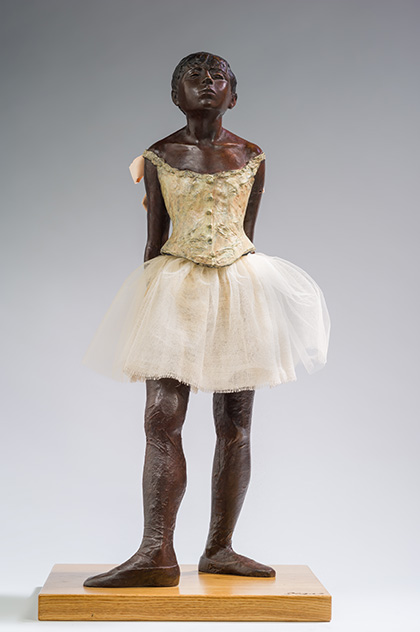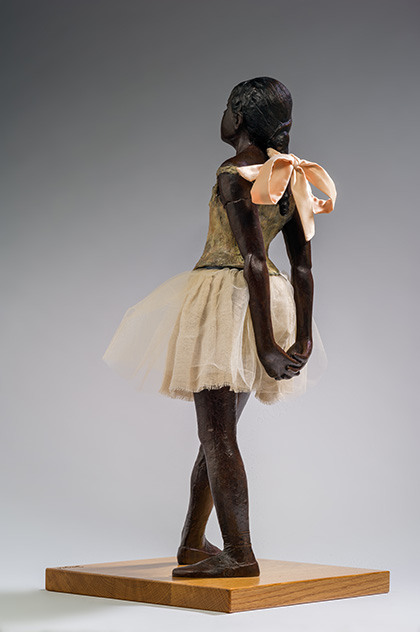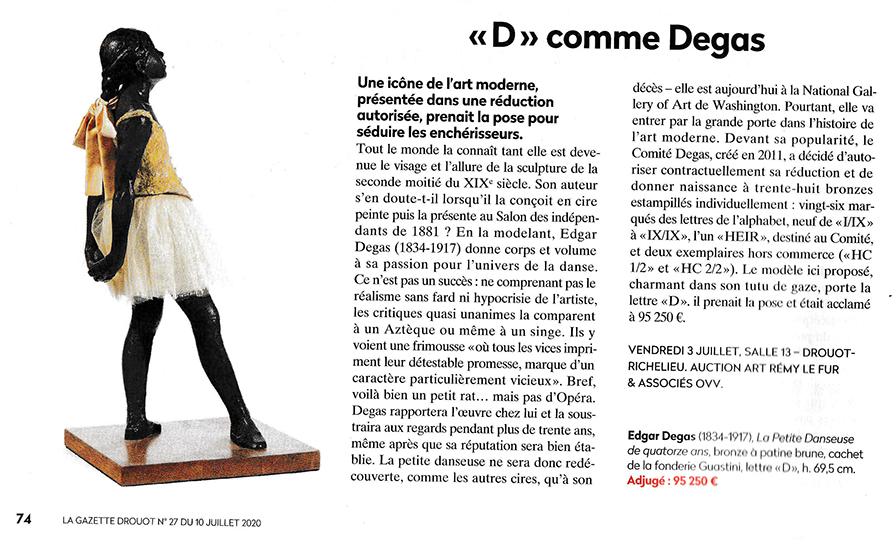 home
about
artists
exhibitions press
contact
purchase
home
about
artists
exhibitions press
contact
purchase |
|
|
EDGAR DEGAS (1834-1917) The Little Dancer Aged Fourteen Edgar Degas (19 July 1834 – 27 September 1917), born Hilaire-Germain-Edgar De Gas was a French artist famous for his work in painting, sculpture and drawing. Degas is considered to be one of the founders of Impressionism although he rejected the term and preferred to be called a realist. A superb draughtsman, he is especially identified with the subject of the dance, and over half his works depict dancers. These display his mastery in the depiction of movement, as do his racecourse subjects and female nudes. Early in his career, his ambition was to be a history painter, a calling for which he was well prepared by his rigorous academic training and close study of classic art. In his early thirties, he changed course, and by bringing the traditional methods of a history painter to bear on contemporary subject matter, he became a classical painter of modern life.He was able to indulge his passion for collecting works by artists he admired: old masters El Greco and such contemporaries as Manet, Pissaro, Cezanne, Gauguin and Van Gogh. Three artists he idolized, Ingres, Delacroix and Daumier were especially well represented in his collection. In the late 1880s, Degas also developed a passion for photography. He photographed many of his friends, often by lamplight, as in his double portrait of Renoir and Mallarmé. Other photographs, depicting dancers and nudes, were used for reference in some of Degas' drawings and paintings. Although he is known to have been working in pastel as late as the end of 1907, and is believed to have continued making sculpture as late as 1910. He never married and spent the last years of his life, nearly blind, restlessly wandering the streets of Paris before dying in 1917. The model for The Little Dancer sculpture was a ballet student at the Paris Opéra, where Degas often drew and painted. The only sculpture Degas ever allowed to be exhibited was The Little Dancer, which he placed in the sixth Impressionist Exhibition of 1881. His contemporaries were shocked by the unprecedented realism of the piece. The sculpture was made of yellow wax and dressed in a cloth costume, including a gauze tutu and a ribbon in her hair. That wax sculpture is now in the National Gallery of Art, Washington DC. It was a gift from Paul Mellon, who bought 69 of Degas's original wax sculptures in 1955. After his death, his heirs enlisted the Hébrard foundry in Paris to cast 74 of the approximately 150 wax and clay sculptures, all in bad condition, that had been found in his home. After the end of World War I, Hébrard assigned its master founder, Albino Palazzolo, to make 22 bronzes of each sculpture: 20 for sale and one each for the Hébrard and Degas families (the number of bronzes made of The Little Dancer was not specified). After Palazzolo had completed 657 bronzes, the Hébrard foundry failed during the Great Depression and went out of business. Palazzolo is widely believed to have cast the balance of the 1,400 or so known bronzes to be made from the Degas models at another foundry, the Valsuani foundry, in the years immediately after World War II. Until now Degas sculptures have survived in three forms: wax originals, which were repaired shortly after his death in 1917 (now mostly in the National Gallery of Art in Washington DC); a master (modèle) set of bronzes made in 1919 from modified waxes by the Hébrard Foundry (now in the Norton Simon Museum, Pasadena); and a series of Hébrard bronze cast made from the master bronzes from 1919 to 1936 and again from 1955 to 1964 (dispersed among museums and private collections). The plot of the Little Dancer’s story has recently thickened with one of the most extraordinary art finds of the past one hundred years. A complete set of 74 plasters of dancers, bathers and horses, including The Little Dancer, attributed to Edgar Degas, which was discovered in the Valsuani Foundry in Paris. According to Walter Maibaum, a leading authority on 19th and 20th Century European art, the discovery of these plasters was the “…equivalent of opening King Tut’s tomb in Egypt or uncovering the terracotta warriors in China.” Gregory Hedberg, an art historian attached to a New York art gallery, gathered evidence that includes carbon dating and a series of letters that suggest the casts were made during the late 19th and 20th century for the private use of Degas’ friend, the sculptor Albert Batholomé. It is from these plasters that the new bronzes are being cast, one set of which is currently on show at the Herakleidon Museum in Athens (until 14 August 2010). Another set of bronzes will tour North American museums, starting in November 2011 at the New Orleans Museum of Art (an appropriate venue, since Degas stayed in the city in 1872-73).Maibaum argues that the plasters are closer to Degas’ original wax sculptures than the bronzes that were cast after his death from the modified waxes. Also creating copies from a bronze model (as was done with the Degas sculptures already in museums) leads to a shrinkage of around 2% and distortions can be introduced. He believes any potential faker would have had to have access to a complete set of bronzes, and that creating the plasters would be a “near impossible” task. The curator of the Tel Aviv Museum of Art (where the exhibition will run until 26 June), who is also the museum’s director and an expert on sculpture, Mordechai Omer, told The Art Newspaper that having studied the Degas plasters, he is “firmly convinced that they and the resulting bronzes are authentic”. He admits to not consulting the leading Degas scholars (who include Richard Kendall of the Clark Art Institute in Massachusetts, Catherine Chevillot of the Musée d’Orsay in Paris and Joseph Czestochowski, co-author of Degas Sculptures: Catalogue Raisonné of the Bronzes, 2003). He says this is because they are art historians, not sculpture specialists, “which is the expertise needed here”.Today only fewer than half a dozen world experts still question the evidence gathered by Maibaum and Hedberg regarding the authenticity of the plasters. This fact pays further homage to the importance of these sculptures within the current art market. An Hébrard bronze of The Tub sold for $3.8m at Sotheby’s in 2008. An Hébrard cast of The Little Dancer sold at Sotheby’s on 3 February 2009 for £13.3m. According to the March 2010 issue of The Art Newspaper the bronzes cast from the recently discovered plaster of The Little Dancer have been sold for around of $2m each. The Art News of February 2010 issue also indicates that bronzes produced from the "recently discovered" plaster casts of Degas sculptures that were purportedly made during his lifetime are now selling for more than $2million.According to the article by William D. Cohen in Art News, August 2011, in 2009 at the request of Maibaum, Waltzer appraised the Valsuani version of the Little Dancer at $12 million. Waltzer further appraised an American collector’s Little Dancer at $15 million based in part on the sale of an authorized Little Dancer at Sotheby's London in February 2009 for $19 million, surpassing an estimate of $13 million to $17 million. Waltzer's $15 million valuation, he writes, "reflects the uplift that has occurred in the market in the past few years." The legitimate rights holders and legal succession of the artist Edgar Degas recognize the authenticity of the bronze sculptures by Degas, The Little Dancer Aged Fourteen, listed as Hébrard's number 73. The bronzes which the Degas succession recognize authenticity were cast at the Valsuani Foundry in Chevreuse, France, from a previously unknown Degas plaster brought to Valsuani by the master founder of Hébrard, Albino Palazzolo. Insofar no Degas bronze was cast from the plaster prior to Valsuani editions, these are the first and the only recognized bronzes by Degas succession for this sculpted version of the Little Dancer Aged Fourteen. These bronzes were cast in two editions: twelve (12) for the 1997 edition, and thirty four (34) for the 1998 edition Every authentic Degas bronze bears the mark of the Valsuani Foundry, in addition to the number inventory (73) Hébrard, the word "reproduction" required by French law as well as the cast year ("1997" or "1998"). The twelve bronzes of the 1997 each carry one of the following cast references: EF A, EF B, EF C, EF D, EF E, EF F, HC1/6, HC2/6, HC3/6, HC4/6, HC5/6, and HC6/6. Thirty four bronzes the 1998 each carry one of the following cast references: Letters A through T (20 bronzes), HCF, HC1/4, HC2/4, HC3/4, HC4/4, EC, EC, EC, O/T, OO/T, EM I, EM II, EM III, and EM IV. Through this recognition, the estate of Edgar Degas confirms that these bronze sculptures are just as true and authentic in all respects as the Degas bronzes previously cast, bearing the mark of the Hébrard Foundry. Thus, these bronzes, cast at the Valsuani Foundry, must be considered to still be part of the artistic legacy of the artist Edgar Degas. NEW! The reduction of the famous sculpture The Little Dancer Aged Fourteen
In view of the popularity of the
sculpture The Little Dancer Aged Fourteen, the Degas Committee,
created in 2011, decided to contractually authorise its reduction
and to give birth to thirty eight individually stamped bronzes:
|
|
|
|
E-mail: info@hayhillgallery.com |


